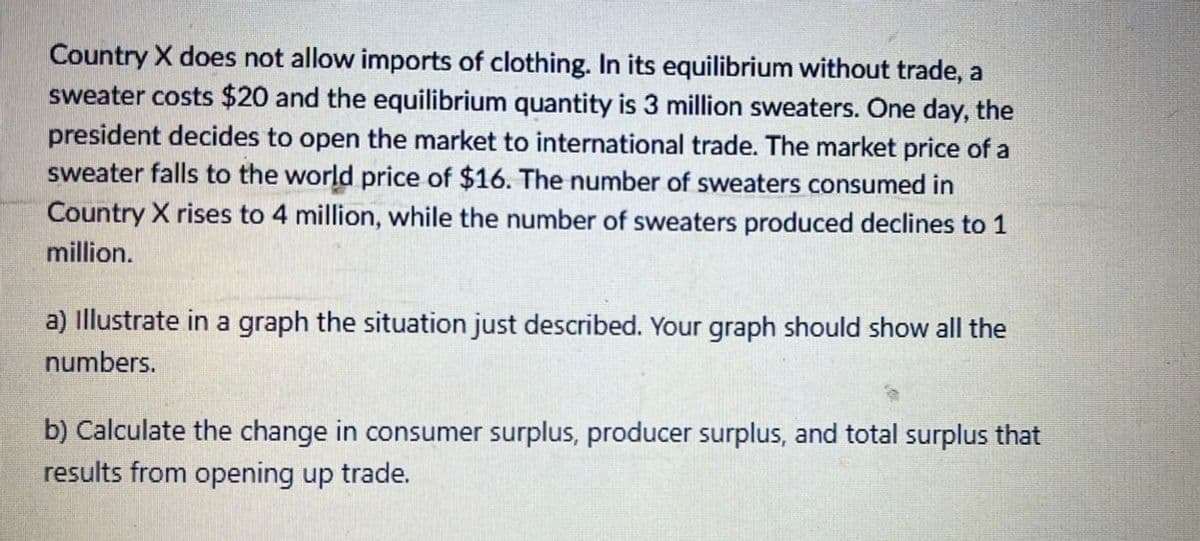Country X does not allow imports of clothing. In its equilibrium without trade, a sweater costs $20 and the equilibrium quantity is 3 million sweaters. One day, the president decides to open the market to international trade. The market price of a sweater falls to the world price of $16. The number of sweaters consumed in Country X rises to 4 million, while the number of sweaters produced declines to 1 million. a) Illustrate in a graph the situation just described. Your graph should show all the numbers. b) Calculate the change in consumer surplus, producer surplus, and total surplus that results from opening up trade.
Country X does not allow imports of clothing. In its equilibrium without trade, a sweater costs $20 and the equilibrium quantity is 3 million sweaters. One day, the president decides to open the market to international trade. The market price of a sweater falls to the world price of $16. The number of sweaters consumed in Country X rises to 4 million, while the number of sweaters produced declines to 1 million. a) Illustrate in a graph the situation just described. Your graph should show all the numbers. b) Calculate the change in consumer surplus, producer surplus, and total surplus that results from opening up trade.
Principles of Macroeconomics (MindTap Course List)
8th Edition
ISBN:9781305971509
Author:N. Gregory Mankiw
Publisher:N. Gregory Mankiw
Chapter9: Application: International Trade
Section: Chapter Questions
Problem 5PA
Related questions
Question

Transcribed Image Text:Country X does not allow imports of clothing. In its equilibrium without trade, a
sweater costs $20 and the equilibrium quantity is 3 million sweaters. One day, the
president decides to open the market to international trade. The market price of a
sweater falls to the world price of $16. The number of sweaters consumed in
Country X rises to 4 million, while the number of sweaters produced declines to 1
million.
a) illustrate in a graph the situation just described. Your graph should show all the
numbers.
b) Calculate the change in consumer surplus, producer surplus, and total surplus that
results from opening up trade.
Expert Solution
This question has been solved!
Explore an expertly crafted, step-by-step solution for a thorough understanding of key concepts.
This is a popular solution!
Trending now
This is a popular solution!
Step by step
Solved in 2 steps with 1 images

Knowledge Booster
Learn more about
Need a deep-dive on the concept behind this application? Look no further. Learn more about this topic, economics and related others by exploring similar questions and additional content below.Recommended textbooks for you

Principles of Macroeconomics (MindTap Course List)
Economics
ISBN:
9781305971509
Author:
N. Gregory Mankiw
Publisher:
Cengage Learning

Principles of Economics, 7th Edition (MindTap Cou…
Economics
ISBN:
9781285165875
Author:
N. Gregory Mankiw
Publisher:
Cengage Learning

Principles of Microeconomics (MindTap Course List)
Economics
ISBN:
9781305971493
Author:
N. Gregory Mankiw
Publisher:
Cengage Learning

Principles of Macroeconomics (MindTap Course List)
Economics
ISBN:
9781305971509
Author:
N. Gregory Mankiw
Publisher:
Cengage Learning

Principles of Economics, 7th Edition (MindTap Cou…
Economics
ISBN:
9781285165875
Author:
N. Gregory Mankiw
Publisher:
Cengage Learning

Principles of Microeconomics (MindTap Course List)
Economics
ISBN:
9781305971493
Author:
N. Gregory Mankiw
Publisher:
Cengage Learning

Principles of Macroeconomics (MindTap Course List)
Economics
ISBN:
9781285165912
Author:
N. Gregory Mankiw
Publisher:
Cengage Learning

Essentials of Economics (MindTap Course List)
Economics
ISBN:
9781337091992
Author:
N. Gregory Mankiw
Publisher:
Cengage Learning

Principles of Economics (MindTap Course List)
Economics
ISBN:
9781305585126
Author:
N. Gregory Mankiw
Publisher:
Cengage Learning